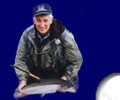

Chumming the Ice - Part 1Grey/Bruce Outdoors For more than a century, Ontario anglers have baited the lake bottom under their ice huts to attract fish. Until recent restrictions came into effect, Lake Simcoe rental hut providers used enormous numbers of summer-caught salted minnows to attract lakers and whitefish for their ice-fishing customers. About twenty-five or thirty years ago, a few Georgian Bay anglers began chumming with salmon roe under their huts or anchored boats and the technique quickly spread. Chumming is now a common practice from Nottawasaga to Wiarton and results in a good number of fish being caught every year. Unlike small lakes or rivers, there is a lot of water in which to try and find fish in the big lakes and chumming can transfer a slow day into a great day with plenty of action. To address depth and current considerations, anglers have refined the practice from dropping the bait through the hole in the ice or over the side of their boats to accurately depositing their fish-attracting baits right below them, using weighted chum cans attached to a heavy line. Lots of chum-can designs exist, all based on the idea of transporting the bait to the bottom where it can be dumped out in an enticing pile where baited and weighted hooks can follow. If you're fishing in 5-10 feet of water with no current, dropping your chum over the side or through the ice-hut hole can work pretty good but if there is any current at all or if you're fishing in 80-100 foot depths, the chum is long gone before it gets to the bottom, spread out for dozens of meters or washed down-current far from your fishing location. How much to chum is also important to fishing success. Initially you might wish to chum the equivalent of a soup can of bait, followed by one quarter of that amount every half hour or so. It isn't necessary to chum very much once you get feeding fish beneath you, perhaps just a bit when the bites slow down. You can chum too much and lower the odds of fish taking your bait, or not enough to really attract any fish to your general area. Strangely, Georgian Bay anglers who try and catch lakers and whitefish with minnows for bait, even chumming salties the way they do Simcoe style, report poor results compared to those chumming a few salmon eggs and fishing with roe. Since salmon eggs are not a normal part of the general food supply for deep water fish species, why roe is such an attraction is a mystery that has yet to be solved. Now that some of our Georgian Bay streams close for upstream angling earlier than in the past to protect spawning salmon, many of the "five-gallon pail chummers" may have to be a little more frugal with their eggs. At one time it wasn't uncommon to see anchored jig-fishermen in Meaford, Owen Sound, Wiarton or the Notty river mouth dipping scoop after scoop of eggs over the side to attract fish. One year I discovered that chumming a mixture of pasta called “stelline” with a handful of eggs worked pretty good and extended my egg supply considerably. For about a week after I first tried it some of my friends reported catching lakers, rainbows and whitefish with little star-shaped pasta in their stomachs. Another chum extender is tapioca, flavoured with eggs or a little cod liver oil. According to one local angler, this mixture can also double as a snack if the fishing is a little slow. In Fisherman magazine writer and retired MNR District Director Gord Pyzer told me that he has even seen big whitefish gobbling macaroni that he dropped into shallow water near his Kenora home on Lake of the Woods. When it comes to making a chumming can, my favourite style is made from an ordinary soup can with a simple hinge, magnetic latch, weighted lid and a screen on the top. The screen is keep the bait in the can but leave a scent trail leading down to bottom. I've watched on my graph as passing fish suddenly dropped down thirty feet to my bait after intercepting the scent trail left from the can's passage. I dedicate a short stiff rod with a free-spooling level wind reel to lowering and raising my chum can and I use a non-stretch Dacron trolling line so I can pop the release at the bottom or a few feet above to spread out the bait. Chumming is legal in Ontario and it works quite well, although attracting the fish won't necessarily make them bite. A future column will address local tackle, baits and fishing techniques
|
|
Web Site owned and operated
by Outdoor Connections.
|